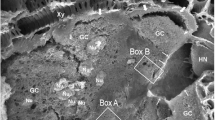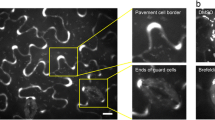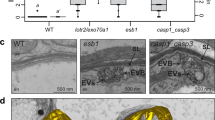Summary
Rosettes of six particles have been visualized by freeze-fracture in the protoplasmic fracture (PF) faces of: a) the plasma membrane, b) Golgi cisternae, and c) Golgi-derived vesicles in mesophyll cells ofZinnia elegans that had been induced to differentiate synchronously into tracheary elements in suspension culture. These rosettes have been observed previously in the PF face of the plasma membranes of a variety of cellulose-synthesizing cells and are thought to be important in cellulose synthesis. InZinnia tracheary elements, the rosettes are localized in the membrane over regions of secondary wall thickening and are absent between thickenings. The observation of rosettes in the Golgi cisternae and vesicles suggests that the Golgi apparatus is responsible for the selective transport and exocytosis of rosettes in higher plants, as has been previously indicated in the algaMicrasterias (Giddings et al. 1980). The data presented indicate that the Golgi apparatus has a critical role in the control of cell wall deposition because it is involved not only in the synthesis and export of matrix components but also in the export of an important component of the cellulose synthesizing apparatus. The rosettes are present in the plasma membrane and Golgi vesicles throughout the enlargement of the secondary thickening, suggesting that new rosettes must be continually inserted into the membrane to achieve complete cell wall thickening.
Similar content being viewed by others
Abbreviations
- EF :
-
Golgi vesicles, exoplasmic fracture; the plasma membrane, extracellular fracture
- PF :
-
protoplasmic fracture
References
Akazawa T, Hara-Nishimura I, (1985) Topographic aspects of biosynthesis, extracellular secretion, and intracellular storage of proteins in plant cells. Annu Rev Plant Phys 36: 441–472
Allen DM, Northcote DH, (1975) The scales ofChrysochromulina chiton. Protoplasma 83: 389–412
Bolwell GP, Northcote DH, (1983) Arabinan synthase and xylan synthase activities ofPhaseolus vulgaris. Subcellular localization and possible mechanism of action. Biochem J 210: 497–507
Bowles DJ, Northcote DH, (1972) The sites of synthesis and transport of extracellular polysaccharides in the root tissues of maize. Biochem J 130: 1133–1145
Branton D, Bullivant S, Gilula NB, Karnovsky MJ, Moor H, Mühlethaer K, Northcote DH, Packer L, Satir B, Satir P, Speth V, Staehelin LA, Steere RL, Weinstein RS, (1975) Freeze-etching nomenclature. Science 190: 54–56
Brown RM, Jr, (1969) Observations on the relationship of the Golgi apparatus to wall formation in the marine Chrysophycean algaPleurochrysis scherffelii Pringsheim. J Cell Biol 41: 109–123
—, (1985) Cellulose microfibril assembly and orientation: Recent developments. J Cell Sci [Suppl] 2: 13–32
Burgess J, (1985) An introduction to plant cell development. Cambridge University Press, Cambridge, England, p 101
—, (1984)In vitro tracheary element formation: structural studies and the effect of tri-iodobenzoic acid. Planta 160: 481–489
Cronshaw J, Bouck GB, (1965) The fine structure of differentiating xylem elements. J Cell Biol 24: 415–431
Dixon WT, Northcote DH, (1985) Plant cell secretory processes. In:Dean RT, Stahl P (eds) Developments in cell biology: secretory processes. Butterworth, London, p 77
Dobberstein B, Kiermayer O, (1972) Das Auftreten einer besonderen Typs von Golgivesikeln während der Sekundärwandbildung vonMicrasterias denticulata Bréb. Protoplasma 75: 185–194
Emons AMC, (1985) Plasma membrane rosettes in root hairs ofEquisetum hyemale. Planta 163: 350–359
Falconer MM, Seagull RW (1985) Immunofluorescent and Calcofluor White staining of developing tracheary elements inZinnia elegans L. suspension cultures. Protoplasma 125: 190–198
Farquhar MG, Palade GE, (1983) The Golgi apparatus (complex) (1954–1981)-from artifact to center stage. J Cell Biol: Discovery in Cell Biology 91: 77s-103s
Fukuda H, Komamine A (1980) Establishment of an experimental system for the study of tracheary element differentiation from single cells isolated from the mesophyll ofZinnia elegans. Plant Phys 65: 57–60
Giddings TH, Jr, Brower DL, Staehelin LA, (1980) Visualization of particle complexes in the plasma membrane ofMicrasterias denticulata associated with the formation of cellulose fibrils in primary and secondary walls. J Cell Biol 84: 327–339
Goosen-de Roo L, (1973) The relationship between cell organelles and cell wall thickenings in primary tracheary elements of the cucumber. I. Morphological aspects. II. Quantitative aspects. Acta Bot Neerl 22 (4): 279–300, 301–320
Herth W, (1983) Arrays of plasma membrane “rosettes” involved in cellulose microfibril formation ofSpirogyra. Planta 159: 347–356
—,Weber G, (1984) Occurrence of putative cellulose-synthesizing “rosettes” in the plasma membrane ofGlycine max suspension cultures cells. Naturwiss 71: 153–154
—, (1985) Plasma-membrane rosettes involved in localized wall thickening during xylem vessel formation ofLepidium sativum L. Planta 164: 12–21
Kiermayer O, Dobberstein B, (1973) Membrankomplexe dictyosomater Herkunft als „Matrizen“ für die extraplasmatische Synthese und Orientierung von Microfibrillen. Protoplasma 77: 437–451
Markham R, Frey S, Hills GJ, (1963) Methods for the enhancement of image detail and accentuation of structure in electron microscopy. Virology 20: 88–102
Mueller SC, Brown RM, Jr, (1980) Evidence for an intramembrane component associated with a cellulose microfibril synthesizing complex in higher plants. J Cell Biol 84: 315–326
Northcote DH, (1985) Cell organelles and their function in biosynthesis of cell-wall components: Control of cell-wall assembly during differentiation. In:Higuchi T (ed) Biosynthesis and biodegradation of wood components. Academic Press, New York
Pickett-Heaps JD, (1966) Incorporation of radioactivity into wheat xylem walls. Planta 71: 1–14
Preston RD, (1974) The physical biology of plant cell walls. Chapman and Hall, London, pp 41, 292
Ray PM, Eisinger R, Robinson DG, (1976) Organelles involved in cell wall polysaccharide formation and transport in pea cells. Ber Dtsch Bot Ges 89: 129–146
Reiss H-D, Schnepf E, Herth W, (1984) The plasma membrane ofFunaria caulonema tip cell: morphology and distribution of particle rosettes, and the kinetics of cellulose synthesis. Planta 160: 428–435
—,Herth W, Schnepf E, (1985) Plasma-membrane “rosettes” are present in the lily pollen tube. Naturwiss 72: 276
Romanovicz DK, Brown RM, Jr, (1976) Biogenesis and structure of Golgi-derived cellulosic scales inPleurochrysis. II. Scale composition and supramolecular structure. Appl Polym Symp 28: 587–610
Schnepf E, Witte E, Rudolph U, Deichgräber G, Reiss H-D, (1985) Tip cell growth and the frequency and distribution of particle rosettes in the plasmalemma. Experimental studies inFunaria protonemata cells. Protoplasma 127: 222–229
Srivastava LM, Singh AP, (1972) Certain aspects of xylem differentiation in corn. Can J Bot 50: 1795–1804
Staehlin LA, Giddings TH, (1982) Membrane-mediated control of cell wall microfibrillar order. In:Subtelny S, Green PB (eds) Developmental order: its origin and regulation. Alan Liss, New York, p 133
Volkmann D, (1983) A freeze-fracture study on the differentiation of Golgi and plasma membranes in plant cells. Eur J Cell Biol 30: 258–265
Wada M, Staehelin LA, (1981) Freeze-fracture observations on the plasma membrane, the cell wall and the cuticle of growing protonemata ofAdiantum capillus — veneris L. Planta 151: 462–468
Wilkinson MJ, Northcote DH, (1980) A reliable method of obtaining matched replicas of freeze-fractured cell suspensions. J Cell Sci 42: 389–400
Willison JHM, (1983) The morphology of supposed cellulose-synthesizing structures in higher plants. J Appl Polym Sci: Appl Polym Symp 37: 91–105
Wooding FBP, (1968) Radioautographic and chemical studies of incorporation into sycamore vascular tissue walls. J Cell Sci 3: 71–80
—,Northcote DH, (1964) The development of the secondary wall of the xylem inAcer pseudoplatanus. J Cell Biol 23: 327–337
Author information
Authors and Affiliations
Rights and permissions
About this article
Cite this article
Haigler, C.H., Brown, R.M. Transport of rosettes from the golgi apparatus to the plasma membrane in isolated mesophyll cells ofZinnia elegans during differentiation to tracheary elements in suspension culture. Protoplasma 134, 111–120 (1986). https://doi.org/10.1007/BF01275709
Received:
Accepted:
Issue Date:
DOI: https://doi.org/10.1007/BF01275709




